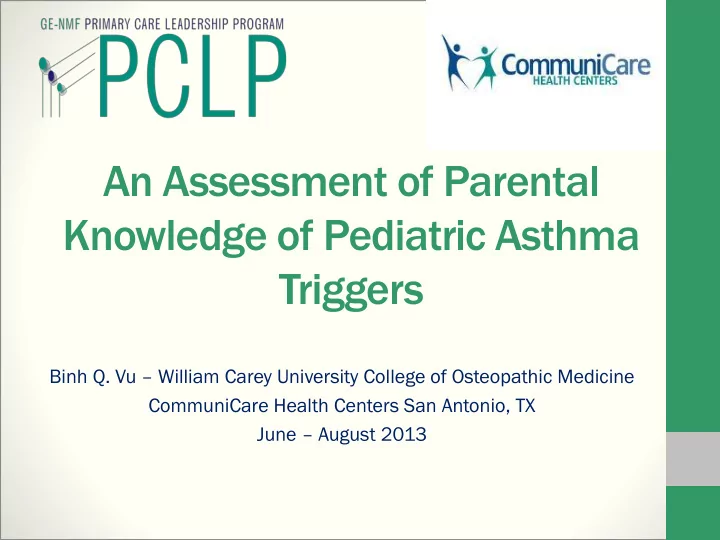

An Assessment of Parental Knowledge of Pediatric Asthma Triggers Binh Q. Vu – William Carey University College of Osteopathic Medicine CommuniCare Health Centers San Antonio, TX June – August 2013
Personal History • 1988 - Born in Vietnam • 1994 - Immigrated to USA in Houston, TX • 2006 - Graduated High School • 2010 - B.S. Biology - University of Houston • 2011 - M.S. Medical Sciences – University of North Texas HSC • 2016 - Doctor of Osteopathic Medicine – William Carey COM • Certified Pharmacy Technician, First Aid and CPR Instructor, National Health Service Corp Scholar
Introduction • Asthma is an inflammatory disease of the lungs • Asthma symptoms: narrowed airway, wheezes, chest tightness, shortness of breath, coughs • Asthma affects all ages • Could be heritable • Asthma attacks may result in hospitalizations, ER visits, missed school days, lost work days for parents. • Rescue inhalers vs. Preventive inhalers • PURPOSE OSE: : To assess parent’s knowledge level of asthma and its triggers. • GOAL: L: To educate patient and parent about avoiding asthma triggers and ultimately prevent asthma exacerbations
Methodology • Study duration: June 17 – July 19, 2013 • Inclusion criteria: • Parent of a child <= 18 years of age • Seen by a CommuniCare provider at the East, West, or NW campus for asthma AND have Hx of asthma/wheezing • Information collected via survey included • Patient age, gender, zip code • 11 questions regarding asthma trigger knowledge • Two additional questions to assess patient’s comfort of participating in research • Descriptive trend analyses of responses
Results • 41 partic ticipants ipants (21 female, 20 male) • Median age of 7 • 36 (88%) participants report of usually developing asthma symptoms at home. • 27 (66%) participants report asthma symptoms worsen during winter er months nths (Dec, Jan, Feb). • 32 (78%) participants report having asthma symptoms with weather her changes ges. • 33 (80%) participants report using/have air freshen shener er produc ucts ts in household. • 31 (76%) participants report using/have fabric ic softene ner r sheets ts in household.
Where Child Usually Develop Asthma Symptoms 40 36 35 Number of responses 30 23 Daycare 25 20 School 15 Home 10 7 5 0 Does your child have symptoms when exposed to any of the following 35 32 30 Stress Number of Responses 25 25 Air Freshener Exercise 20 18 16 Air Quality Alerts 15 Cold Air 12 11 10 Dust Cold/Flu 5 2 Weather Changes 0
Time of year asthma symptoms are worse 30 27 Number of responses 23 25 Summer: Jun/Jul/Aug 20 Spring: Mar/Apr/May 17 15 15 Fall: Sept/Oct/Nov Winter: Dec/Jan/Feb 10 5 0 Does your household use any of the following? 35 33 31 29 Wood burn stove 30 Number of Responses Dampness 25 Mold Humidifier 20 16 Fireplace 15 Cockroaches Pets 10 Perfume 3 4 5 5 Fabric Softener Sheets 1 Air Freshener Products 0
Su Summar mary y of f findings ndings • Asthma symptoms occur at home • Asthma symptoms occur the fall and winter months • Strong belief that asthma symptoms are due to weather changes, cold/flu, and dust • Low perception about the effect of air fresheners, fabric softener sheets, and perfume on pulmonary irritation
Fu Futur ure e dire irectio ctions ns for r a a Commu muniCa niCare re as asthm hma a ed educatio cation, n, pre reven vention, tion, an and in inter erven vention tion pro rogram gram • Identify where CommuniCare patients and providers obtain their asthma trigger information • Fill knowledge gaps among CommuniCare patients and providers regarding the effect of air fresheners, fabric softener sheets, and perfume on pulmonary irritation • Increased focus on patient health literacy regarding the differences between rescue and preventive asthma medication • Assess the feasibility of adopting asthma symptoms mitigation programs in other US cities • Develop FQHC-specific program evaluation tool for asthma treatment ( e.g., reduction in need for acute care )
Acknowledgements My deepest gratitude to Dr. Medr drano, , Dr. Ramos os, , Dr. Vaz azquez uez, , Dr. Jae aen, , Dr. Morei eira ra, , Dr. Gar arza, , an and d Kari i Prem emsiri siri for the support, guidance, mentorship, and love during this summer program. Thank you all for making my experience with CommuniCare remarkable and unforgettable.
Recommend
More recommend